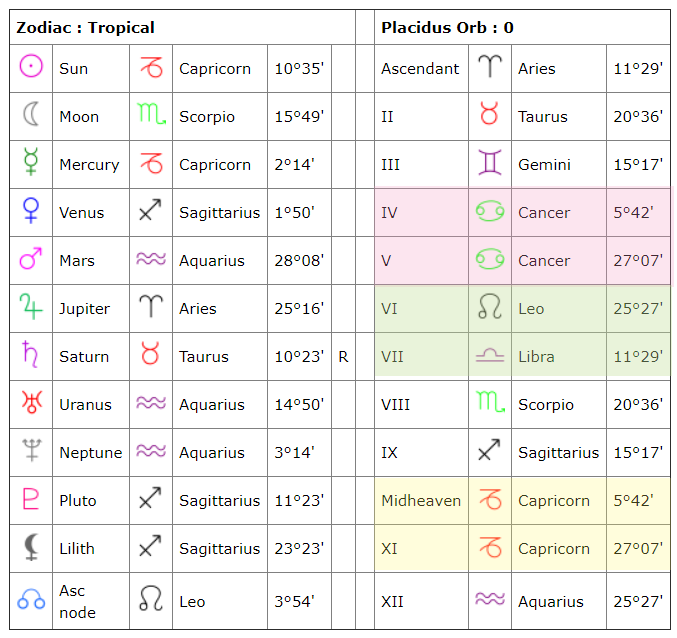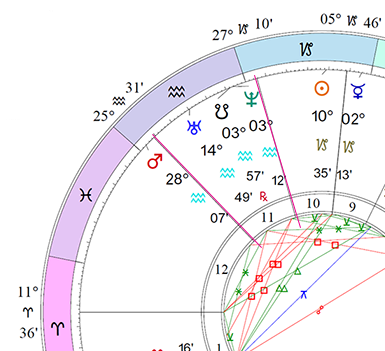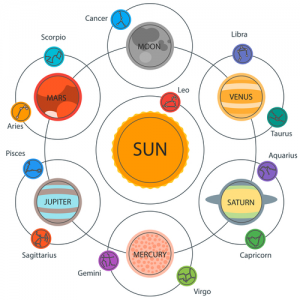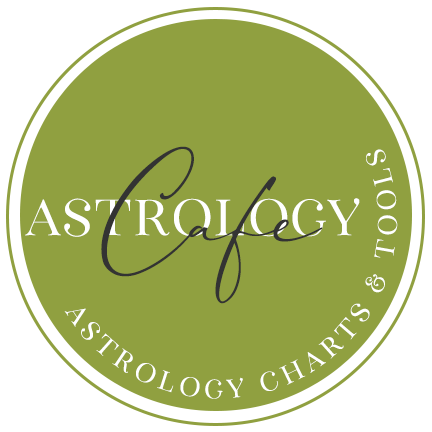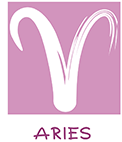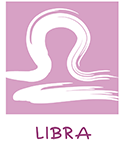Understanding the Astrological Chart Wheel
How to Read the Houses in a Chart Wheel
The following tutorial can help demonstrate how to understand the houses of an astrology chart wheel by looking at the chart wheel itself. This mostly applies to uneven house systems, such as Placidus, Koch, Regiomontanus, Campanus, and more.
This article assumes that you know how to read the sign and planetary symbols for this tutorial. If you don’t, then please refer to the symbols here: Astrology Symbols: Signs and Astrology Symbols & Glyphs. You might also benefit from learning about the polarities or opposite signs here: Polarities: Opposite Signs and Houses.
I’ve tried to summarize the answer in the following video. However, it’s explained in detail below.
I am using the example chart with data: January 1, 2000, at 12:00 PM, in Toronto, Canada. This is the default chart in the Free Report Section here.
When you enter this data in the Free Report Section of the site, you will see a list or table of planetary positions and house cusps in the report itself, which I have copied here:
I am going to address two very common issues or concerns that people have in the beginning stages of learning astrology:
- Duplicated or Missing Signs on the house cusps, and
- Planets in signs that don’t match the signs on the house cusps.
First,
1. Duplicated or Missing Signs on the house cusps
With many house systems, including the popular Placidus house system (the default house system in the Free Reports Section), house sizes are uneven. Very frequently, only some of the 12 zodiac signs are represented on the house cusps. And, when this is the case, some signs are on two house cusps.
This is the case of interceptions. An intercepted sign is a sign that doesn’t appear ON a house cusp. I emphasize “on” because every sign is found in every chart. However, some signs are found within a house in their entirety and are not showing up on house cusps.
There is a basic rule: when a sign is intercepted, its opposite sign is also intercepted. Additionally, this happens in opposite houses.
As well, when a sign and its opposite sign are intercepted in a chart, you can be certain that you will see two signs that are each found on two house cusps.
Referring to the example chart’s table above, you can see that the sign of Cancer is found on both the fourth (IV) and fifth (V) houses.
This is not a mistake. Many people write to me about this issue, many of whom feel that it’s a software error, glitch, or mistake, but it’s not. This is completely normal and quite common, in fact.
Because Cancer appears on two consecutive houses, you can be certain that Cancer’s opposite sign, Capricorn, appears on two consecutive houses, as well. Not only that, you can be certain that this will happen on opposite houses. The fourth and fifth houses are opposite the tenth (X) and eleventh (XI) houses, and in this case, these are the houses with Capricorn on the cusp.
See the following. Please hover over the highlighted areas for further information:
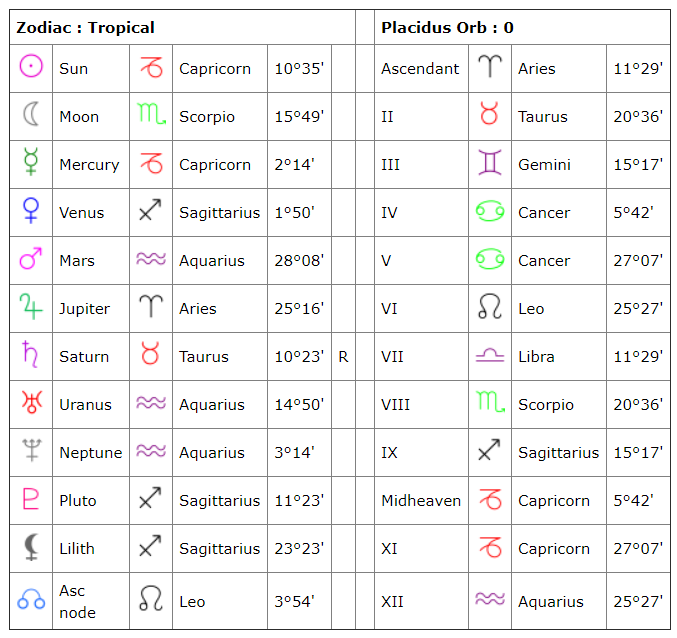
Duplicated Signs
The sign of Cancer is found on two consecutive house cusps: the fourth (IV) and fifth (V) houses.
Capricorn on two houses
The sign of Capricorn (Cancer's opposite sign) is also found on two consecutive house cusps -- on the 10th house cusp (Note: the Midheaven is the 10th house cusp) and on the 11th house cusp (XI). Note also that the degrees next to the sign's name are the same as those of Cancer.
Leo (Virgo) Libra
Note that Leo is on the cusp of the sixth (VI) house and Libra is on the cusp of the seventh (VII) house. Since Virgo comes after Leo, you can see that Virgo is "missing" or not represented on the houses of this chart. Virgo is said to be intercepted in the sixth house.
This also means that Virgo's opposite sign, Pisces, is not found on a house cusp in this particular chart.
In the above table:
Highlighted in pink is an example of Duplicated Signs. The sign of Cancer is found on two consecutive house cusps: the fourth (IV) and fifth (V) houses.
Highlighted in green is Leo (Virgo) Libra. Note that Leo is on the cusp of the sixth (VI) house and Libra is on the cusp of the seventh (VII) house. Since Virgo comes after Leo, you can see that Virgo is “missing” or not represented on the houses of this chart. Virgo is said to be intercepted in the sixth house. This also means that Virgo’s opposite sign, Pisces, is not found on a house cusp in this particular chart.
Highlighted in yellow is an example of the sign of Capricorn on two houses. The sign of Capricorn (Cancer’s opposite sign) is also found on two consecutive house cusps — on the 10th house cusp (Note: the Midheaven is the 10th house cusp) and on the 11th house cusp (XI). Note also that the degrees next to the sign’s name are the same as those of Cancer.
The chart wheel of this set of birth information is as follows:
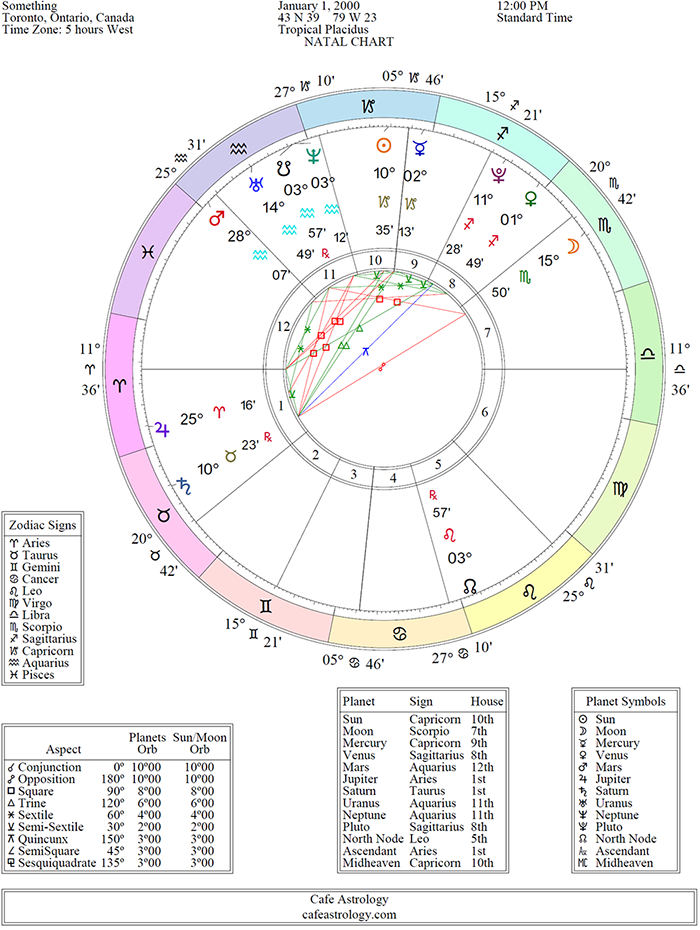
Cancer on Cusps of 4th and 5th
Note that the fourth house cusp (the beginning point of the fourth house) falls within the Cancer range. The fifth house cusp (the beginning point of the fifth house) also falls within the scope of the sign of Cancer. This example illustrates a case of duplicated signs on the house cusps, which is very common in most house systems.
Virgo is intercepted in the sixth house
Note that the full sign of Virgo is found within the sixth house. Leo is on the cusp of the sixth house and Libra is on the cusp of the seventh house. Virgo is not on any house cusp, but is fully represented in the chart.
Please hover over or click the highlighted areas for further information.
The chart wheel of this set of birth information is as follows:
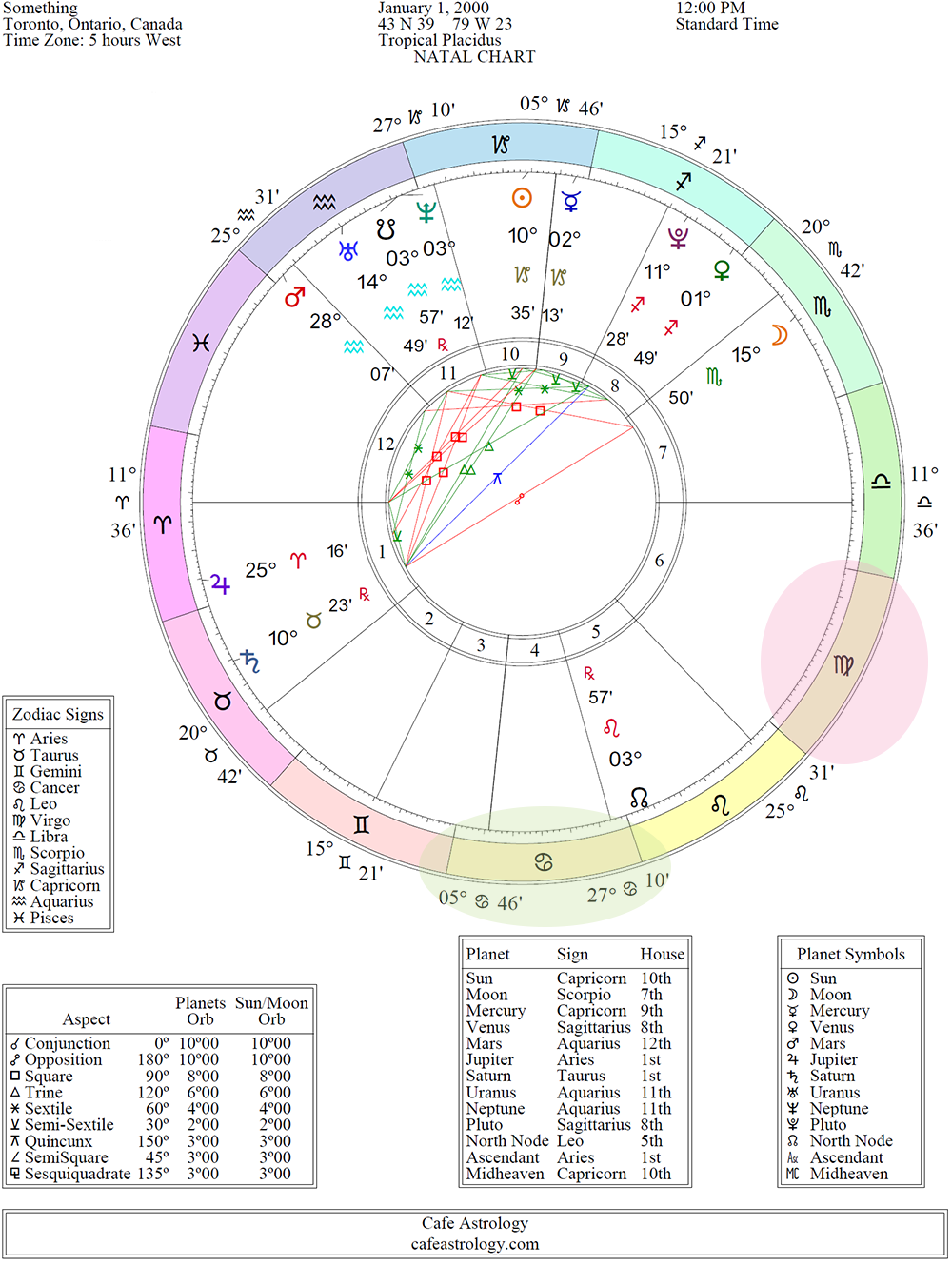
The Cancer sign range is shown in green and the Virgo sign range is shown in pink in the image above.
Note that the fourth house cusp (the beginning point of the fourth house) falls within the Cancer range. The fifth house cusp (the beginning point of the fifth house) also falls within the scope of the sign of Cancer. This example illustrates a case of duplicated signs on the house cusps, which is very common in most house systems.
Note that the full sign of Virgo is found within the sixth house. Leo is on the cusp of the sixth house and Libra is on the cusp of the seventh house. Virgo is not on any house cusp, but is fully represented in the chart.
Keep in mind that we look at a chart as “starting” at the first house and then move along in a counterclockwise direction. The beginning of the fourth house is the fourth house cusp, and it’s at 5 degrees Cancer and 46 minutes. That’s where the fourth house begins. The fifth house begins at the fifth house cusp, and this is where the fourth house ends. The fifth house begins at 27 degrees Cancer and 10 minutes.
The same thing can be said for Capricorn except that it’s a mirror image. Capricorn is on both the tenth (opposite the fourth) house and the eleventh (opposite the fifth) house.
Both Virgo and its opposite sign, Pisces, are intercepted. They are found completely within houses 6 and 12, respectively. This is also quite normal and completely expected with duplicated signs, as well.
Signs map out consecutively in the chart but they don’t always show up on the house cusps. Keep in mind that a house cusp is just a point in the chart. If Virgo and Pisces are not on a house cusp as in the example chart, the signs are still there in the chart in their entirety, they just didn’t make it to a house cusp!
Secondly,
2. Planets in signs that don’t match the signs on the house cusps
This is another frequent concern for new students of astrology when dealing with house systems such as Placidus where houses are uneven: why planets in signs don’t always match the signs on the house cusps.
Keep in mind that each sign holds 30 degrees. A sign represents a range or one-twelfth of a 360-degree circle. There are 12 signs each at 30 degrees, and 12 x 30º = 360º
However, in a house system such as Placidus, houses are not all 30 degrees. Even when they are, the houses typically don’t begin at zero degrees of a sign.
As such, most houses hold more than one sign. There are houses that hold part of one sign and part of another. There are also houses that hold part of one sign, all of the next sign, and then part of the following sign as is the case of the example chart on this page (the sixth house). As well, there are houses that hold only part of one sign and that’s it, as is the case for the fourth house of the example chart on this page.
For most house systems, in other words, one house ≠ one sign (one house does not equal one sign).
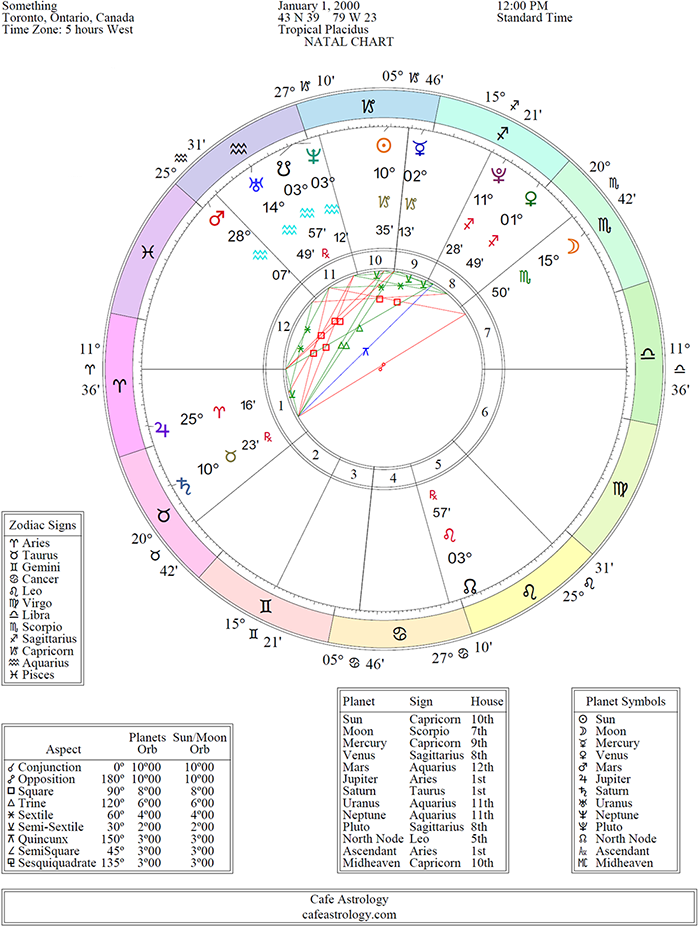
Planets in Aquarius in a House with Capricorn on the Cusp
Here you can find Capricorn on the cusp of the eleventh house with planets Neptune and Uranus in Aquarius in the eleventh house.
Mars is also in Aquarius but is found in the next house, the twelfth house.
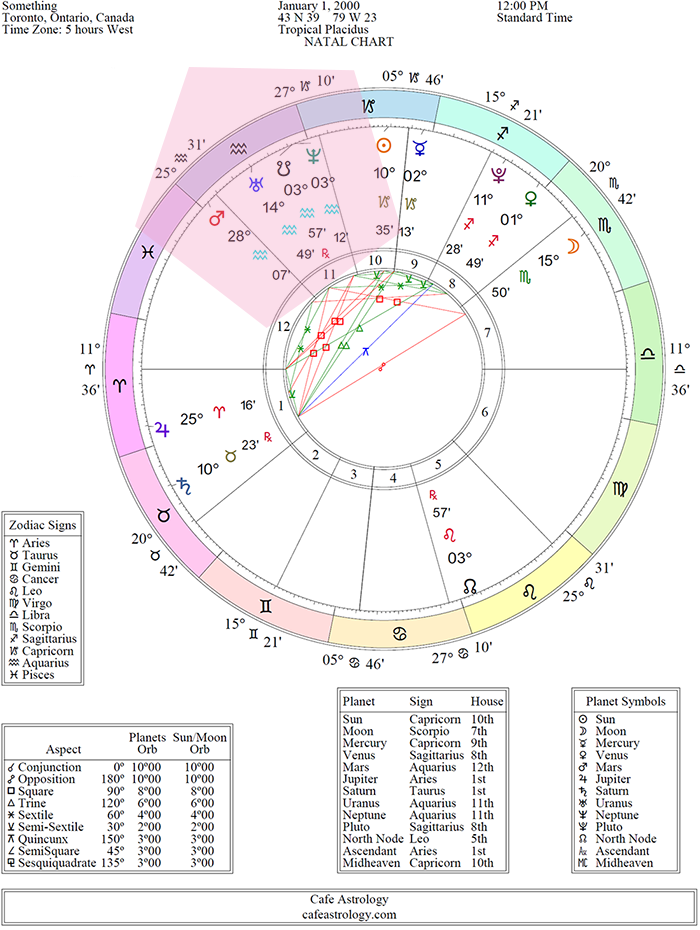 The above illustrates a situation in which planets in Aquarius are found in a house with Capricorn on the cusp.
The above illustrates a situation in which planets in Aquarius are found in a house with Capricorn on the cusp.
Here you can find Capricorn on the cusp of the eleventh house with planets Neptune and Uranus in Aquarius in the eleventh house.
Mars is also in Aquarius but is found in the next house, the twelfth house.
While Capricorn is on the cusp of the eleventh house, there are two planets (and the South Node of the Moon) that are in the sign of Aquarius and also in the eleventh house. Aquarius is on the twelfth house cusp, but Neptune and Uranus, both in Aquarius, are in the eleventh house. Mars in Aquarius IS in the twelfth house.
This is not a mistake. I receive frequent emails about this type of issue. However, once you understand that there is a 30-degree range attached to each sign and that planets can fall at various points along that range and still be in the same sign, things begin to make sense.
In this example, the eleventh house begins near the end of Capricorn, at 27 degrees (out of 30). So, we have only the last 3 degrees or so of Capricorn falling in the eleventh house. This is why the Sun, falling earlier in the sign (at about 10 degrees) of Capricorn, is NOT found in the eleventh house. Instead, it falls within the tenth house.
The eleventh house, then, includes the last 3 degrees (or so) of Capricorn, and then the first 25 degrees (or so) of Aquarius, because the eleventh house ends where the twelfth house begins, and the twelfth house begins at 25 degrees Aquarius and 31 minutes.
Mars falls near the end of the sign Aquarius, at 28 degrees Aquarius (out of 30 degrees). It falls after the beginning of the twelfth house (25 degrees Aquarius is the cusp/beginning of the twelfth house) and thus is said to be in the twelfth house. In other words, we can make the statement that Mars is in the 12th house of this example chart.
Similarly, since the eleventh house spans the range from 27 to 30 degrees Capricorn plus 0 to 25 degrees of Aquarius, then Neptune at 3 degrees Aquarius and Uranus at 14 degrees Aquarius fall within the eleventh house, and we can make the statements: Neptune is in the eleventh house and Uranus is in the eleventh house for this example chart.
Looking at the 11th house more closely:
Example Chart: The Eleventh House
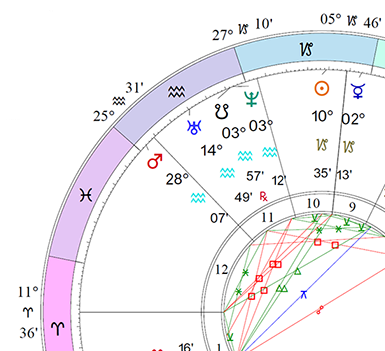
eleventh house
Highlighted here is the 11th house.
Notice how the eleventh house begins at 27 degrees Capricorn 10 minutes, and that this falls near the end of the blue band of Capricorn. The eleventh house then spans through most of the purple band of Aquarius, but not all of Aquarius. The 12th house begins late in the sign of Aquarius, at 25 degrees Aquarius and 31 minutes. Mars falls outside of the 11th house--Mars falls within the 12th house because its coordinates are later in the sign of Aquarius than the twelfth house cusp.
Highlighted here is the 11th house.
Notice how the eleventh house begins at 27 degrees Capricorn 10 minutes, and that this falls near the end of the blue band of Capricorn. The eleventh house then spans through most of the purple band of Aquarius, but not all of Aquarius. The 12th house begins late in the sign of Aquarius, at 25 degrees Aquarius and 31 minutes. Mars falls outside of the 11th house–Mars falls within the 12th house because its coordinates are later in the sign of Aquarius than the twelfth house cusp.
Keeping in mind that we move counter-clockwise, the eleventh house is highlighted in the above diagram. It begins late in the sign of Capricorn (![]() ) (in this diagram, the blue band) and spans most, but not all, of the sign of Aquarius (
) (in this diagram, the blue band) and spans most, but not all, of the sign of Aquarius (![]() ) (in this diagram, the purple band). Mars clearly falls beyond the range of the 11th house.
) (in this diagram, the purple band). Mars clearly falls beyond the range of the 11th house.
Looking at the 11th house more closely:
Highlighted here is the 11th house.
Notice how the eleventh house begins at 27 degrees Capricorn 10 minutes, and that this falls near the end of the blue band of Capricorn. The eleventh house then spans through most of the purple band of Aquarius, but not all of Aquarius. The 12th house begins late in the sign of Aquarius, at 25 degrees Aquarius and 31 minutes. Mars falls outside of the 11th house–Mars falls within the 12th house because its coordinates are later in the sign of Aquarius than the twelfth house cusp.
Keeping in mind that we move counter-clockwise, the eleventh house boundaries are highlighted as pink lines in the above diagram. It begins late in the sign of Capricorn (![]() ) (in this diagram, the blue band) and spans most, but not all, of the sign of Aquarius (
) (in this diagram, the blue band) and spans most, but not all, of the sign of Aquarius (![]() ) (in this diagram, the purple band). Mars clearly falls beyond the range of the 11th house.
) (in this diagram, the purple band). Mars clearly falls beyond the range of the 11th house.
Return to the Free Report Section of Cafe Astrology.
For your reference:
The following tables show the polarities or opposites for each sign and house.
| Sign | Opposite Sign |
|---|---|
| Aries | Libra |
| Taurus | Scorpio |
| Gemini | Sagittarius |
| Cancer | Capricorn |
| Leo | Aquarius |
| Virgo | Pisces |
| House | Opposite House |
|---|---|
| First I | Seventh VII |
| Second II | Eighth VIII |
| Third III | Ninth IX |
| Fourth IV | Tenth X |
| Fifth V | Eleventh XI |
| Sixth VI | Twelfth XII |
The Houses of a Chart:Hover over and then click on each house for a pop-up description:
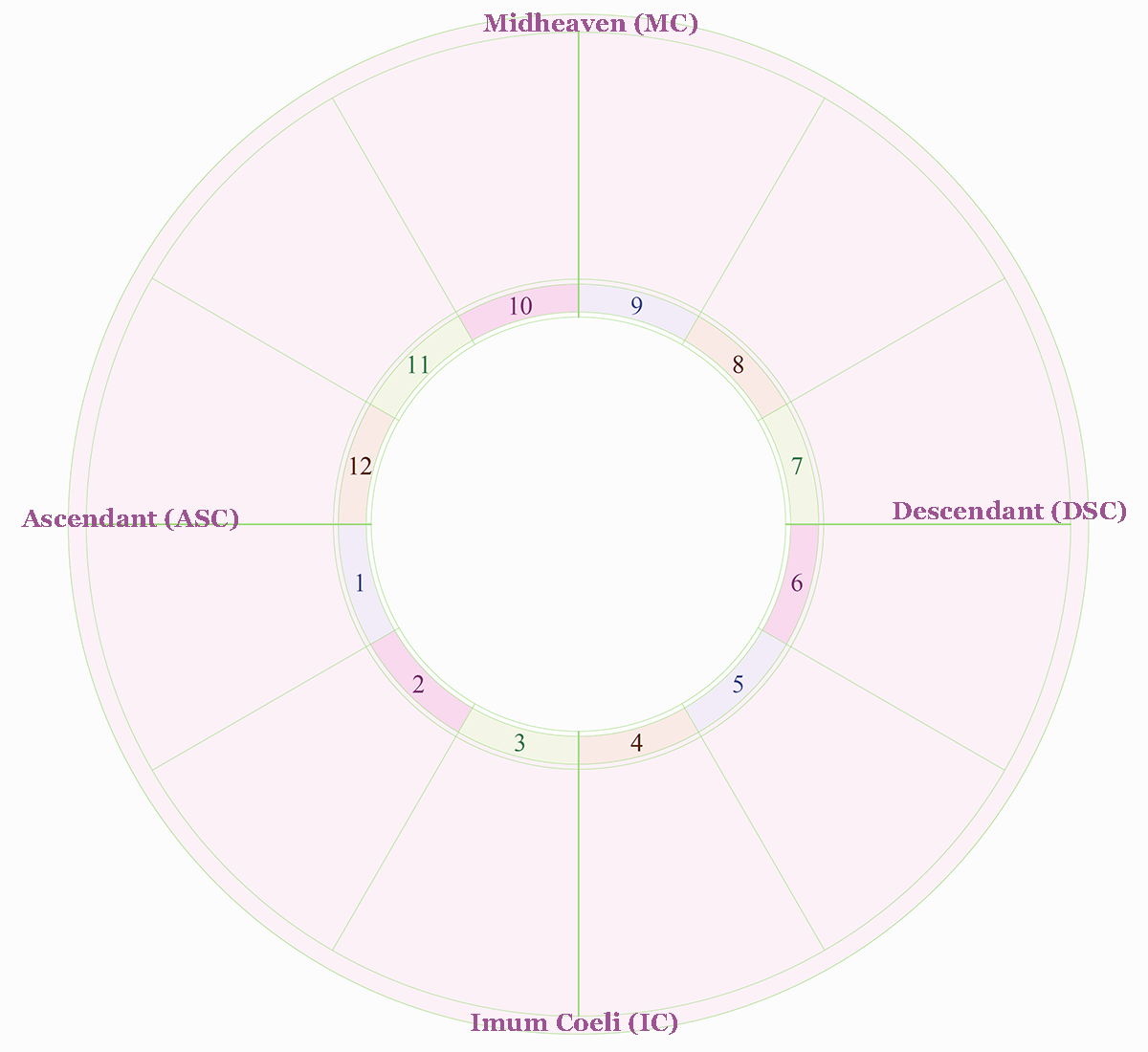
The First House
The First House: Self-Image
The cusp of the first house is a special angle, the Ascendant (also known as the rising sign).
Angular house. Natural sign ruler is Aries and its natural planetary ruler is Mars.
The image we project to others, the first impression we make, how we start things, our defense mechanisms, our relationship with our immediate environment, our general outlook on life, and our physical appearance.
The Second House
The Second House: Self-Worth and Money
The second house is a succedent house. Its natural sign ruler is Taurus and its natural planetary ruler is Venus.
Money and personal finances, sense of self-worth and basic values, personal possessions, natural talents, personal resources, valuables.
The Third House
The Third House: Communication
The third house is a cadent house. Its natural sign ruler is Gemini and its natural planetary ruler is Mercury.
The lower mind, communication, interactions in our immediate environment, siblings and early environment, neighbors, thoughts, short trips, writing and speaking, how we formulate our thoughts, language skills, media, and communications.
The Fourth House
The Fourth House: Family, Home, Roots & Security
The cusp of the fourth house is a special angle called the IC (Immum Coeli or Imum Coeli) and is also called the nadir.
The fourth house is an angular house. Its natural sign ruler is Cancer and its natural planetary ruler is the Moon.
Our psychological foundations and roots, family, home life, instinctive behavior, the mother or the more “maternal” parent/caregiver, ancestry, our connection with our past, our sense of security, domestic life, real estate.
The Fifth House
The Fifth House: Self-Expression, Creativity, Pleasure, & Romance
The fifth house is a succedent house. Its natural sign ruler is Leo and its natural planetary ruler is the Sun.
Creative self-expression, pleasure and entertainment, all forms of “play”, speculation and gambling, pastimes, hobbies, attitude towards romance, romantic relationships, lovers as opposed to partners, attitude towards having fun, drama, adornments and costumes.
The Sixth House
The Sixth House: Work & Health
The sixth house is a cadent house. Its natural sign ruler is Virgo and its natural planetary ruler is Mercury.
Work and job (as opposed to career), techniques and methods, daily life, order, self-improvement, health, nutrition, attitude towards food, service, attitude towards service and co-workers, helpfulness, pets, attitude towards routine and organization, how we refine and perfect ourselves, aptitudes.
The Seventh House
The Seventh House: Partnership & Marriage
The cusp of the seventh house is a special angle called the Descendant (DSC).
The seventh house is an angular house. Its natural sign ruler is Libra and its natural planetary ruler is Venus.
Companionship, the alter ego, partnerships, one-to-one relationships, marriage, the first marriage, the “significant other”, business partnerships, competitors, our “shadow self”, lawyers, mediators, counselors, contracts.
The Eighth House
The Eighth House: Transformation & Sexuality
The eighth house is a succedent house. Its natural sign ruler is Scorpio and its natural planetary ruler is Pluto (Mars).
Transformation and crisis, our attitude towards crisis and change, sexuality, sex, death and rebirth, personal growth and transformation, regeneration, our partner’s resources, addictions, psychology, others’ money, taxes, divorce/alimony, inheritance.
The Ninth House
The Ninth House: Belief Systems & Higher Learning
The ninth house is a cadent house. Its natural sign ruler is Sagittarius and its natural planetary ruler is Jupiter.
Our personal belief system, our sense of adventure, exploration, religious beliefs and personal philosophy, higher education, long-distance travel, morals, foreign languages and cultures, personal truths, publishing, commerce.
The Tenth House
The Tenth House: Career/Profession, Responsibility, Reputation, & Standing
The cusp of the tenth house is a special angle called the Midheaven (MC).
The tenth house is an angular house. Its natural sign ruler is Capricorn and its natural planetary ruler is Saturn.
Career and profession, contribution to society, position in society, social standing, reputation, material success and position, how we carve out an identity for ourselves, achievement, authority figures, paternal figures, the father or most “paternal” parent/caregiver, bosses, governments, attitude towards responsibility, attitude towards abiding by the law, desire for achievement.
The Eleventh House
The Eleventh House: Aspirations & Personal Goals, Groups
The eleventh house is a succedent house. Its natural sign ruler is Aquarius and its natural planetary ruler is Uranus (Saturn).
Acquaintances and friends, groups, organizations, hopes, wishes, aspirations, personal goals, our sense of our true inner purpose, our sense of the group, humanity.
The Twelfth House
The Twelfth House: Soul Growth & Undoing, Privacy & Secrets
The twelfth house is a cadent house. Its natural sign ruler is Pisces and its natural planetary ruler is Neptune (Jupiter).
That which is hidden or below the surface, karma, self-undoing, soul growth, hidden strengths and hidden weaknesses, dreams, private affairs, lost items, hospitals and prisons, spiritual studies.
You May Also Like:
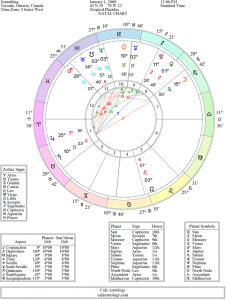
How to Find a Birth Date from a Birth Chart
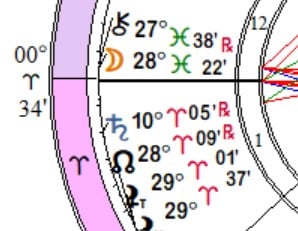
Accuracy of Degrees (and Minutes) of the Ascendant

Understanding the Free Natal Chart Report
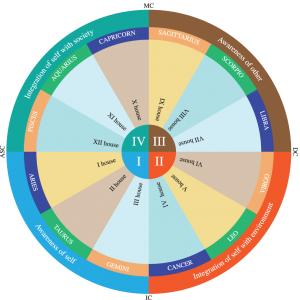
Astrological Houses: Divisions
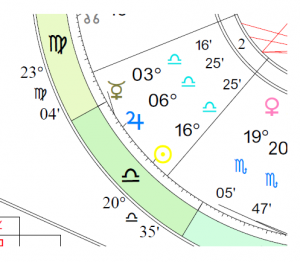
Compare House Systems Report
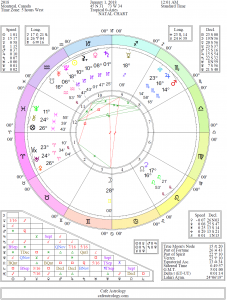
Get Your Astrology Natal/Birth Chart
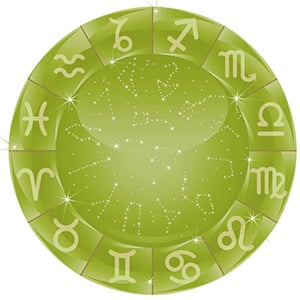
Astrology Reference
See Also:
Sponsored Links:
